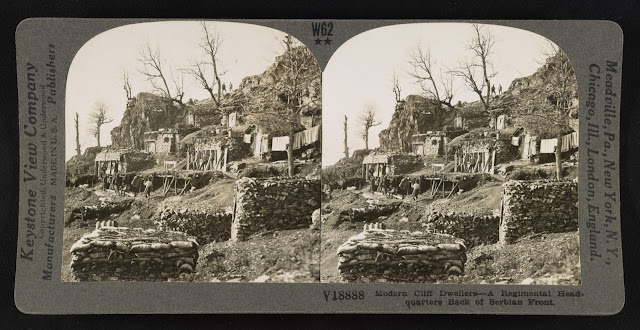- Excerpt from: The World War through the stereoscope a visualized, vitalized history of the greatest conflict of all the ages / / edited by Major Joseph Mills Hanson.
- Published/Created by: Meadville, Pa.; New York, N.Y.; Chicago, Ill.; London, England:
- Keystone View Company, photographed between 1914 and 1918, published 1923
- Repository: Library of Congress Prints and Photographs Division Washington, D.C. 20540 USA
This is a rugged strip of country, typical of Serbia, which is a land of mountains and valeys, and broad treeless plains covered with a growth of scrub. It was no hardship for the hardy Serbians, accustomed to life in the open, to live in rough houses such as these. In fact those who occupied them were infinitely better off than our allies in the trenches in France. These quarters, though crude, were at least dry, and could be made warm and comfortable.
Men who fought in Serbia learned to surmount the obstacles which nature placed in their way. Mountain passes had to be threaded. Countless rivers and streams flowing through narrow valleys had to be crossed and recrossed. The German High Command, aware of the topography of the country, made the most thorough provision for its conquest. It sent hundreds of knock-down "Compackt" bridges, made of steel parts, each part ounched and stamped, ready to be fitted to the other and fastened with bolts and nuts. It sent miles of narrow gauge railroad track, in sections four feet long, each section fitted with a hook to attach it to the next. This railroad could be laid down over rough country at the rate of two miles an hour, and readily taken up and relaid when needed elsewhere.
Small cars carrying about 800 pounds of freight ran on the narrow gauge rails. They were pulled along by horses or donkeys, and sometimes by the soldiers themselves. Near the front they were used only at night, sometimes to carry wounded to the rear, usually to bring up food and supplies. Against this mighty army, equipped with every appliance of modern war, the Serbians fought heroically, succumbing finally only to overwhelming numbers and heavier artillery.







0 Comments